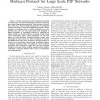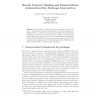132 search results - page 13 / 27 » On Public Key Encryption from Noisy Codewords |
SCN
2010
Springer
14 years 9 months ago
2010
Springer
Exposure of a secret key is a significant threat in practice. As a notion of security against key exposure, Dodis et al. advocated key-insulated security, and proposed concrete k...
SRDS
1993
IEEE
15 years 3 months ago
1993
IEEE
Authentication and key distribution protocols that utilize weak secrets (such as passwords and PINs) are traditionally susceptible to guessing attacks whereby an adversary iterate...
103
click to vote
CCS
2008
ACM
15 years 1 months ago
2008
ACM
Identity-based encryption (IBE) is an exciting alternative to public-key encryption, as IBE eliminates the need for a Public Key Infrastructure (PKI). Any setting, PKI- or identit...
109
click to vote
ICC
2007
IEEE
15 years 3 months ago
2007
IEEE
Overlay networks have shown tremendous potential in solving large scale data dissemination problem by employing peer-to-peer communication protocols. These networks, however, have ...
119
click to vote
ASIACRYPT
2009
Springer
15 years 5 months ago
2009
Springer
Abstract. We describe a public-key encryption scheme based on lattices — specifically, based on the hardness of the learning with error (LWE) problem — that is secure against ...


